Economics 1: Airline Price Discrimination Analysis Report
VerifiedAdded on 2023/01/19
|7
|1109
|60
Report
AI Summary
This economics report examines third-degree price discrimination within the airline industry, focusing on how airlines segment their markets and set prices based on the demand elasticity of different customer groups. The report analyzes factors such as the availability of substitutes, differences in tastes, and income variations to explain why specific passenger groups exhibit varying demand elasticities. It provides a clear illustration of price discrimination through graphs and real-world examples, comparing fares for different booking times and passenger types. The report uses examples from JetBlue and Delta Airlines to highlight the practical application of price discrimination and concludes by emphasizing the importance of considering passenger group elasticities for successful price discrimination strategies. The assignment also includes a brief analysis of airline business models, comparing low-cost carriers (LCC) and full-service network carriers (FSNC) and their effect on operational costs.
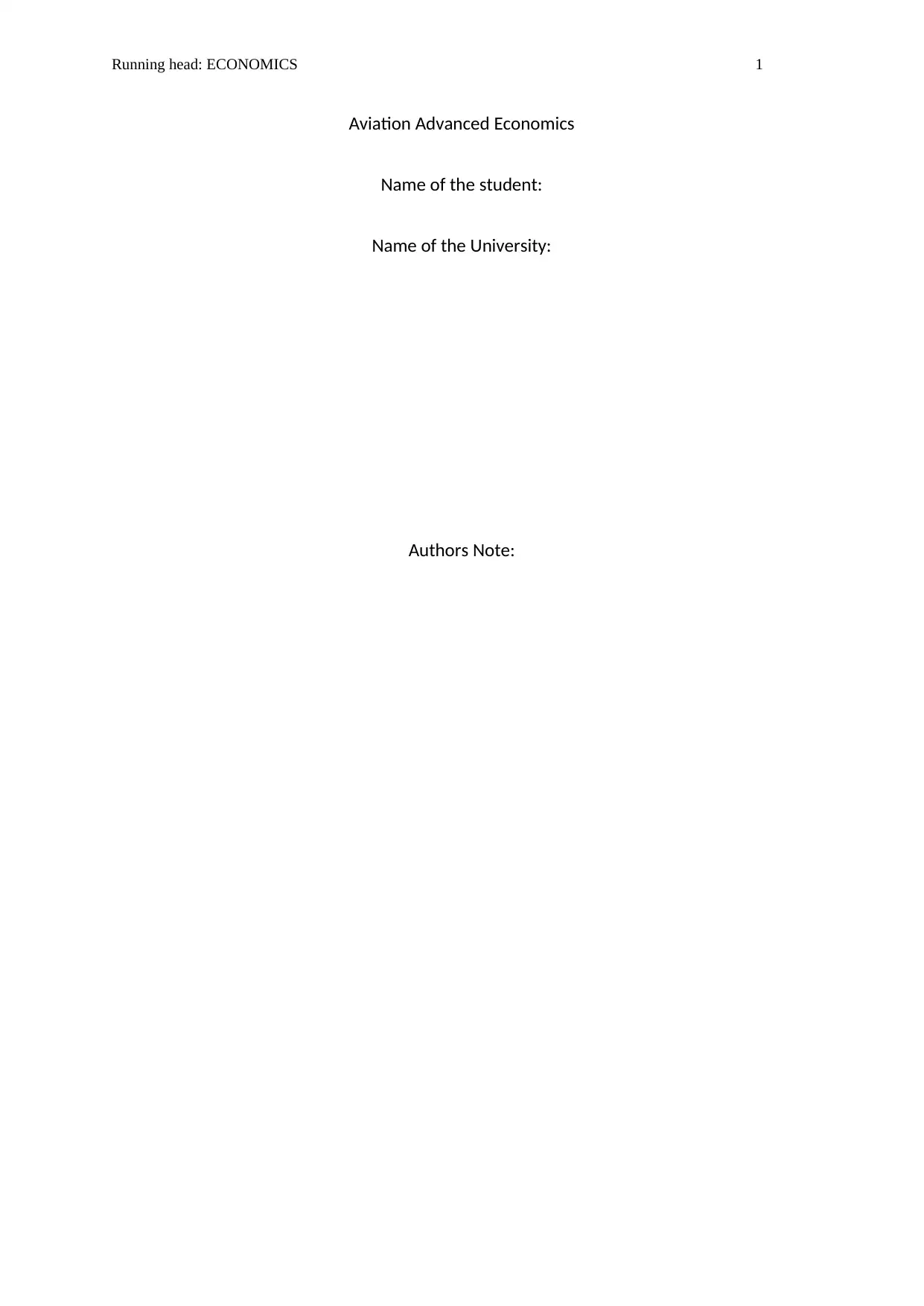
Running head: ECONOMICS 1
Aviation Advanced Economics
Name of the student:
Name of the University:
Authors Note:
Aviation Advanced Economics
Name of the student:
Name of the University:
Authors Note:
Paraphrase This Document
Need a fresh take? Get an instant paraphrase of this document with our AI Paraphraser
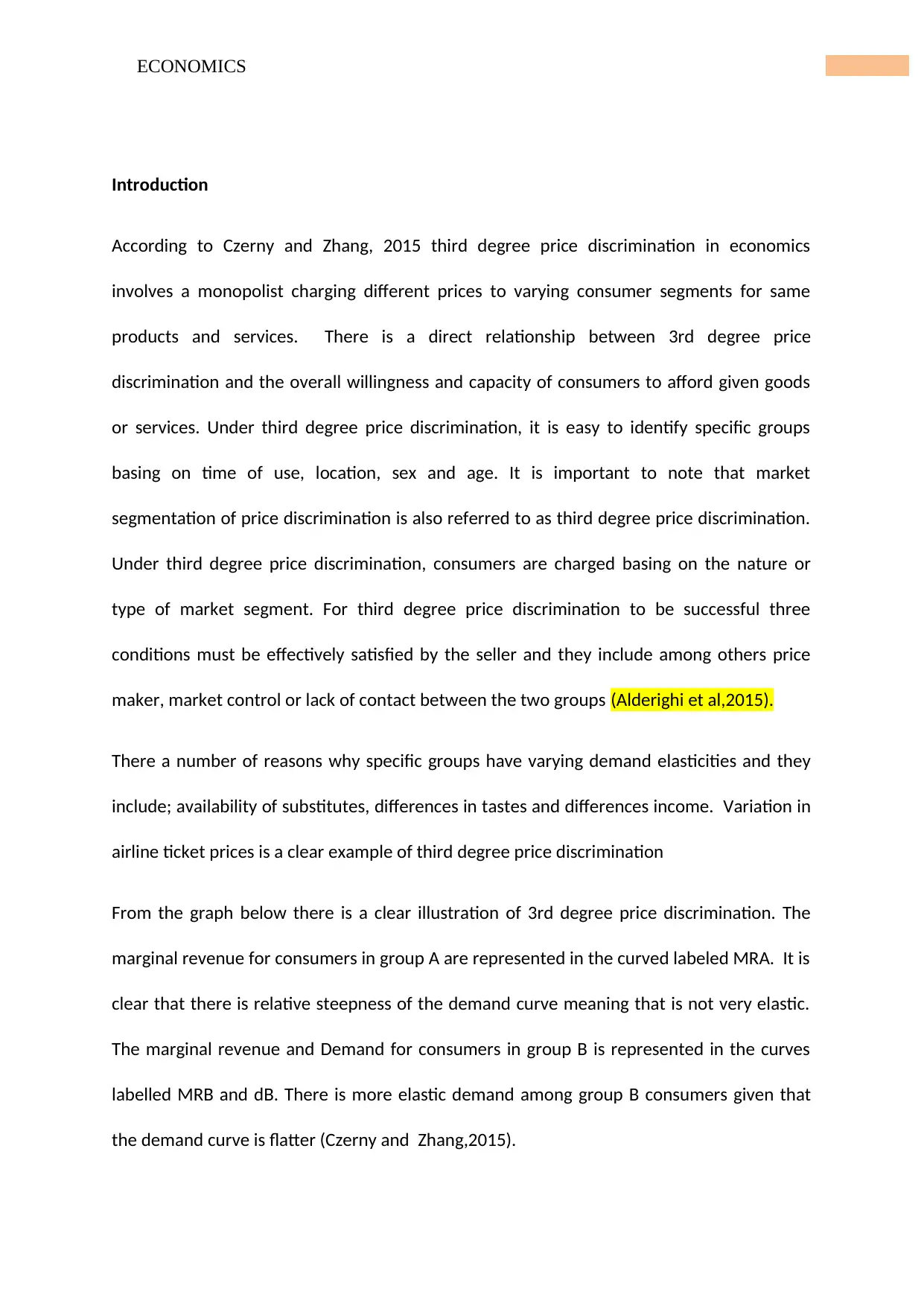
1ECONOMICS
Introduction
According to Czerny and Zhang, 2015 third degree price discrimination in economics
involves a monopolist charging different prices to varying consumer segments for same
products and services. There is a direct relationship between 3rd degree price
discrimination and the overall willingness and capacity of consumers to afford given goods
or services. Under third degree price discrimination, it is easy to identify specific groups
basing on time of use, location, sex and age. It is important to note that market
segmentation of price discrimination is also referred to as third degree price discrimination.
Under third degree price discrimination, consumers are charged basing on the nature or
type of market segment. For third degree price discrimination to be successful three
conditions must be effectively satisfied by the seller and they include among others price
maker, market control or lack of contact between the two groups (Alderighi et al,2015).
There a number of reasons why specific groups have varying demand elasticities and they
include; availability of substitutes, differences in tastes and differences income. Variation in
airline ticket prices is a clear example of third degree price discrimination
From the graph below there is a clear illustration of 3rd degree price discrimination. The
marginal revenue for consumers in group A are represented in the curved labeled MRA. It is
clear that there is relative steepness of the demand curve meaning that is not very elastic.
The marginal revenue and Demand for consumers in group B is represented in the curves
labelled MRB and dB. There is more elastic demand among group B consumers given that
the demand curve is flatter (Czerny and Zhang,2015).
Introduction
According to Czerny and Zhang, 2015 third degree price discrimination in economics
involves a monopolist charging different prices to varying consumer segments for same
products and services. There is a direct relationship between 3rd degree price
discrimination and the overall willingness and capacity of consumers to afford given goods
or services. Under third degree price discrimination, it is easy to identify specific groups
basing on time of use, location, sex and age. It is important to note that market
segmentation of price discrimination is also referred to as third degree price discrimination.
Under third degree price discrimination, consumers are charged basing on the nature or
type of market segment. For third degree price discrimination to be successful three
conditions must be effectively satisfied by the seller and they include among others price
maker, market control or lack of contact between the two groups (Alderighi et al,2015).
There a number of reasons why specific groups have varying demand elasticities and they
include; availability of substitutes, differences in tastes and differences income. Variation in
airline ticket prices is a clear example of third degree price discrimination
From the graph below there is a clear illustration of 3rd degree price discrimination. The
marginal revenue for consumers in group A are represented in the curved labeled MRA. It is
clear that there is relative steepness of the demand curve meaning that is not very elastic.
The marginal revenue and Demand for consumers in group B is represented in the curves
labelled MRB and dB. There is more elastic demand among group B consumers given that
the demand curve is flatter (Czerny and Zhang,2015).
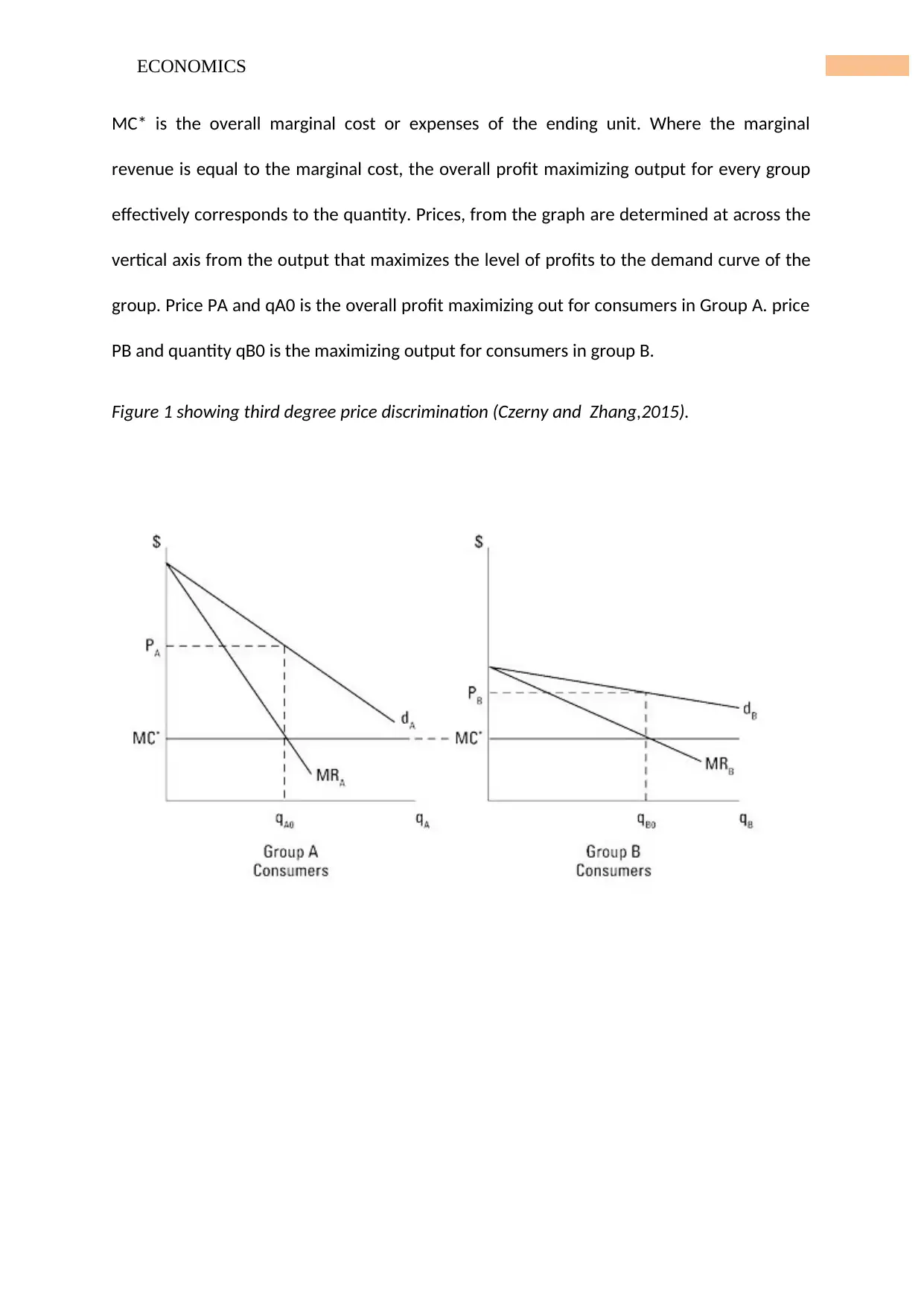
2ECONOMICS
MC* is the overall marginal cost or expenses of the ending unit. Where the marginal
revenue is equal to the marginal cost, the overall profit maximizing output for every group
effectively corresponds to the quantity. Prices, from the graph are determined at across the
vertical axis from the output that maximizes the level of profits to the demand curve of the
group. Price PA and qA0 is the overall profit maximizing out for consumers in Group A. price
PB and quantity qB0 is the maximizing output for consumers in group B.
Figure 1 showing third degree price discrimination (Czerny and Zhang,2015).
MC* is the overall marginal cost or expenses of the ending unit. Where the marginal
revenue is equal to the marginal cost, the overall profit maximizing output for every group
effectively corresponds to the quantity. Prices, from the graph are determined at across the
vertical axis from the output that maximizes the level of profits to the demand curve of the
group. Price PA and qA0 is the overall profit maximizing out for consumers in Group A. price
PB and quantity qB0 is the maximizing output for consumers in group B.
Figure 1 showing third degree price discrimination (Czerny and Zhang,2015).
⊘ This is a preview!⊘
Do you want full access?
Subscribe today to unlock all pages.

Trusted by 1+ million students worldwide
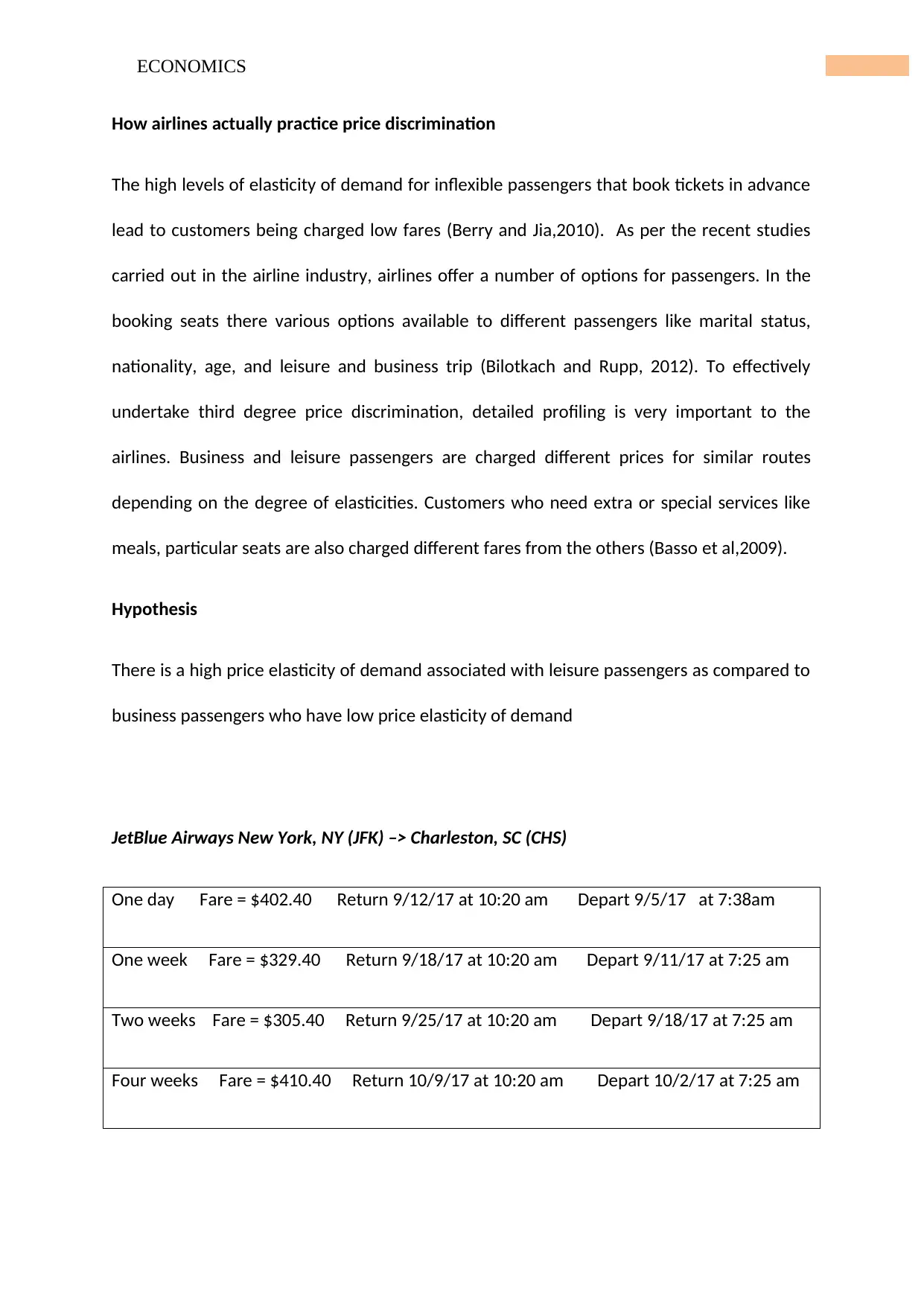
3ECONOMICS
How airlines actually practice price discrimination
The high levels of elasticity of demand for inflexible passengers that book tickets in advance
lead to customers being charged low fares (Berry and Jia,2010). As per the recent studies
carried out in the airline industry, airlines offer a number of options for passengers. In the
booking seats there various options available to different passengers like marital status,
nationality, age, and leisure and business trip (Bilotkach and Rupp, 2012). To effectively
undertake third degree price discrimination, detailed profiling is very important to the
airlines. Business and leisure passengers are charged different prices for similar routes
depending on the degree of elasticities. Customers who need extra or special services like
meals, particular seats are also charged different fares from the others (Basso et al,2009).
Hypothesis
There is a high price elasticity of demand associated with leisure passengers as compared to
business passengers who have low price elasticity of demand
JetBlue Airways New York, NY (JFK) –> Charleston, SC (CHS)
One day Fare = $402.40 Return 9/12/17 at 10:20 am Depart 9/5/17 at 7:38am
One week Fare = $329.40 Return 9/18/17 at 10:20 am Depart 9/11/17 at 7:25 am
Two weeks Fare = $305.40 Return 9/25/17 at 10:20 am Depart 9/18/17 at 7:25 am
Four weeks Fare = $410.40 Return 10/9/17 at 10:20 am Depart 10/2/17 at 7:25 am
How airlines actually practice price discrimination
The high levels of elasticity of demand for inflexible passengers that book tickets in advance
lead to customers being charged low fares (Berry and Jia,2010). As per the recent studies
carried out in the airline industry, airlines offer a number of options for passengers. In the
booking seats there various options available to different passengers like marital status,
nationality, age, and leisure and business trip (Bilotkach and Rupp, 2012). To effectively
undertake third degree price discrimination, detailed profiling is very important to the
airlines. Business and leisure passengers are charged different prices for similar routes
depending on the degree of elasticities. Customers who need extra or special services like
meals, particular seats are also charged different fares from the others (Basso et al,2009).
Hypothesis
There is a high price elasticity of demand associated with leisure passengers as compared to
business passengers who have low price elasticity of demand
JetBlue Airways New York, NY (JFK) –> Charleston, SC (CHS)
One day Fare = $402.40 Return 9/12/17 at 10:20 am Depart 9/5/17 at 7:38am
One week Fare = $329.40 Return 9/18/17 at 10:20 am Depart 9/11/17 at 7:25 am
Two weeks Fare = $305.40 Return 9/25/17 at 10:20 am Depart 9/18/17 at 7:25 am
Four weeks Fare = $410.40 Return 10/9/17 at 10:20 am Depart 10/2/17 at 7:25 am
Paraphrase This Document
Need a fresh take? Get an instant paraphrase of this document with our AI Paraphraser
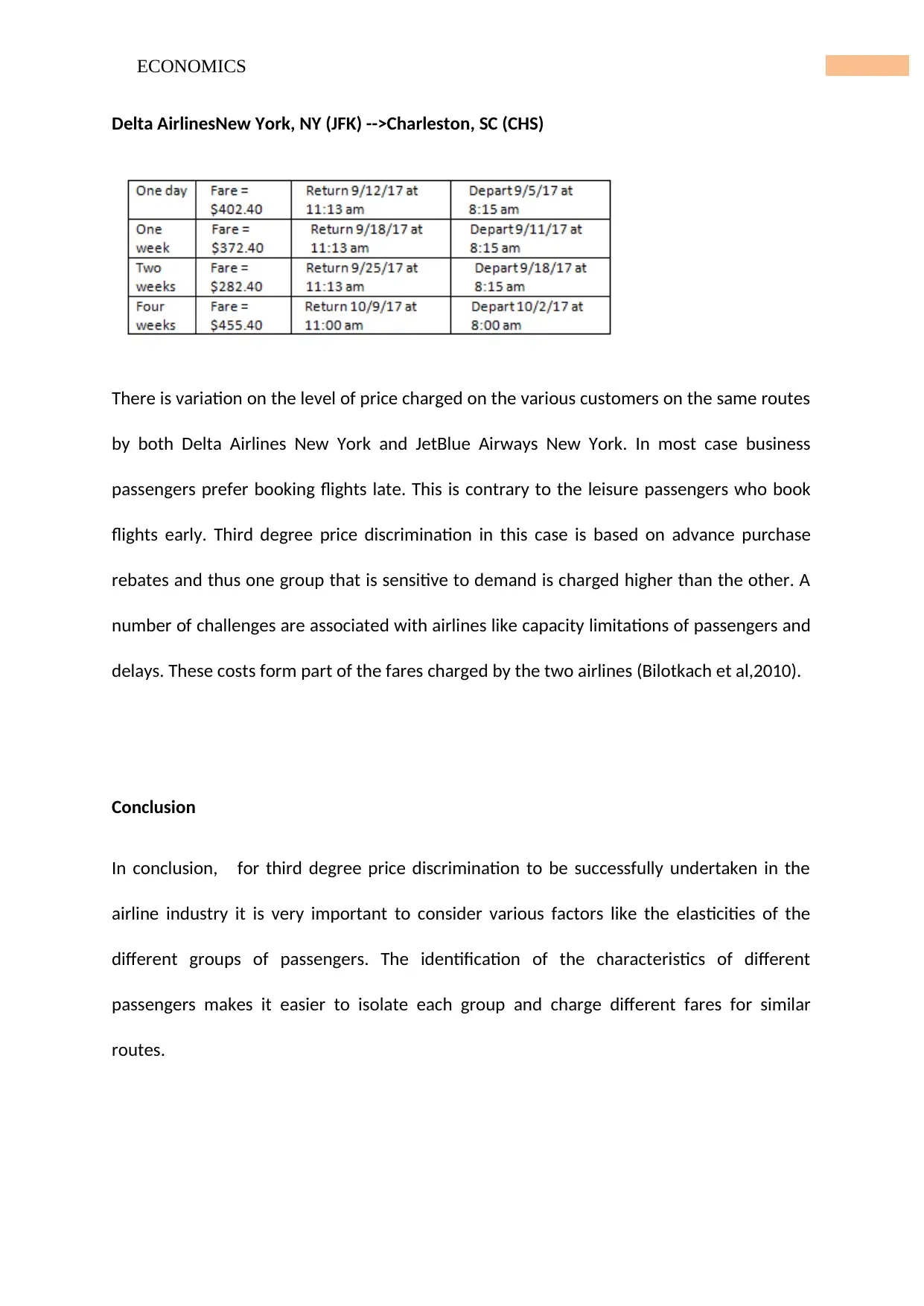
4ECONOMICS
Delta AirlinesNew York, NY (JFK) -->Charleston, SC (CHS)
There is variation on the level of price charged on the various customers on the same routes
by both Delta Airlines New York and JetBlue Airways New York. In most case business
passengers prefer booking flights late. This is contrary to the leisure passengers who book
flights early. Third degree price discrimination in this case is based on advance purchase
rebates and thus one group that is sensitive to demand is charged higher than the other. A
number of challenges are associated with airlines like capacity limitations of passengers and
delays. These costs form part of the fares charged by the two airlines (Bilotkach et al,2010).
Conclusion
In conclusion, for third degree price discrimination to be successfully undertaken in the
airline industry it is very important to consider various factors like the elasticities of the
different groups of passengers. The identification of the characteristics of different
passengers makes it easier to isolate each group and charge different fares for similar
routes.
Delta AirlinesNew York, NY (JFK) -->Charleston, SC (CHS)
There is variation on the level of price charged on the various customers on the same routes
by both Delta Airlines New York and JetBlue Airways New York. In most case business
passengers prefer booking flights late. This is contrary to the leisure passengers who book
flights early. Third degree price discrimination in this case is based on advance purchase
rebates and thus one group that is sensitive to demand is charged higher than the other. A
number of challenges are associated with airlines like capacity limitations of passengers and
delays. These costs form part of the fares charged by the two airlines (Bilotkach et al,2010).
Conclusion
In conclusion, for third degree price discrimination to be successfully undertaken in the
airline industry it is very important to consider various factors like the elasticities of the
different groups of passengers. The identification of the characteristics of different
passengers makes it easier to isolate each group and charge different fares for similar
routes.
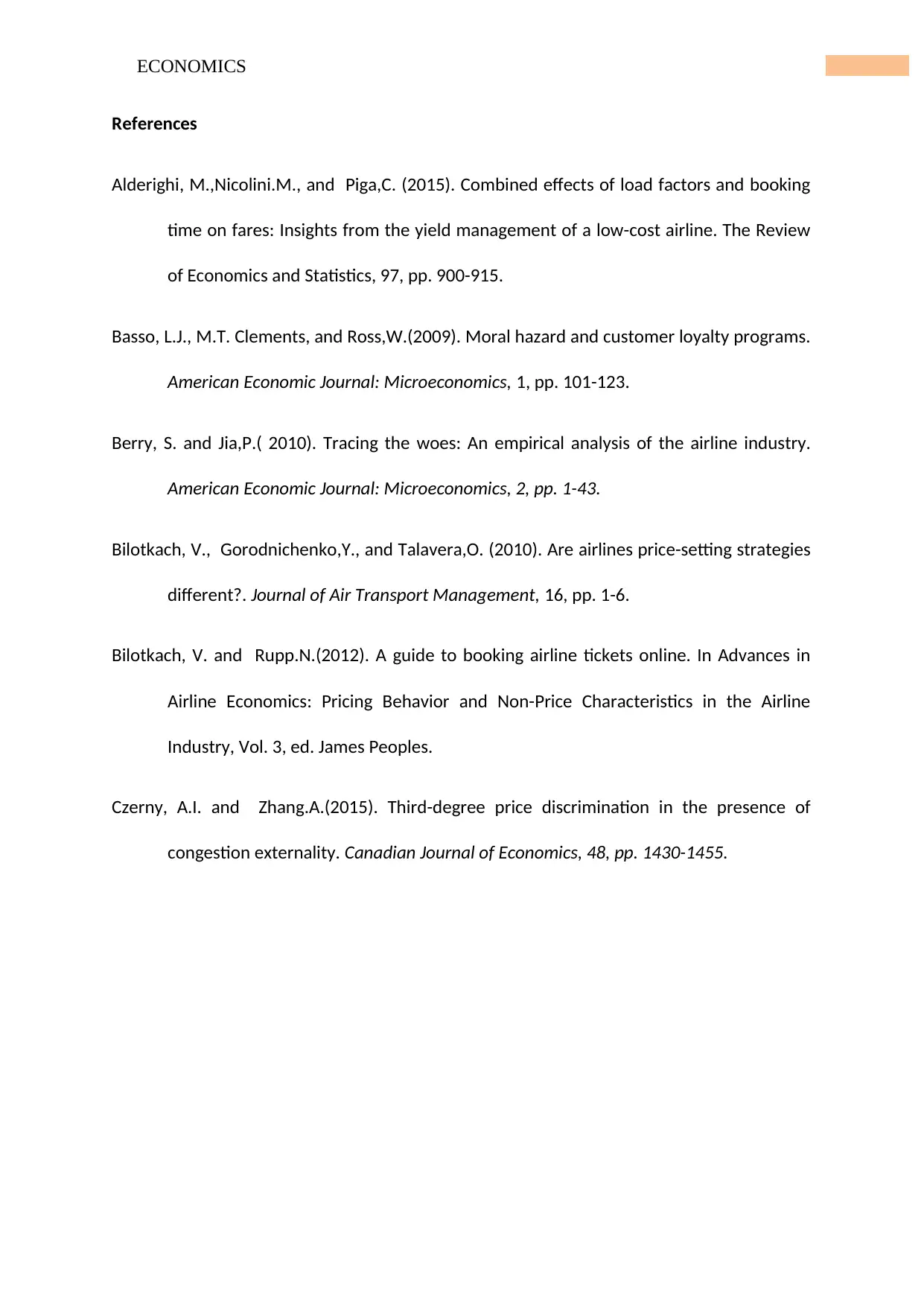
5ECONOMICS
References
Alderighi, M.,Nicolini.M., and Piga,C. (2015). Combined effects of load factors and booking
time on fares: Insights from the yield management of a low-cost airline. The Review
of Economics and Statistics, 97, pp. 900-915.
Basso, L.J., M.T. Clements, and Ross,W.(2009). Moral hazard and customer loyalty programs.
American Economic Journal: Microeconomics, 1, pp. 101-123.
Berry, S. and Jia,P.( 2010). Tracing the woes: An empirical analysis of the airline industry.
American Economic Journal: Microeconomics, 2, pp. 1-43.
Bilotkach, V., Gorodnichenko,Y., and Talavera,O. (2010). Are airlines price-setting strategies
different?. Journal of Air Transport Management, 16, pp. 1-6.
Bilotkach, V. and Rupp.N.(2012). A guide to booking airline tickets online. In Advances in
Airline Economics: Pricing Behavior and Non-Price Characteristics in the Airline
Industry, Vol. 3, ed. James Peoples.
Czerny, A.I. and Zhang.A.(2015). Third-degree price discrimination in the presence of
congestion externality. Canadian Journal of Economics, 48, pp. 1430-1455.
References
Alderighi, M.,Nicolini.M., and Piga,C. (2015). Combined effects of load factors and booking
time on fares: Insights from the yield management of a low-cost airline. The Review
of Economics and Statistics, 97, pp. 900-915.
Basso, L.J., M.T. Clements, and Ross,W.(2009). Moral hazard and customer loyalty programs.
American Economic Journal: Microeconomics, 1, pp. 101-123.
Berry, S. and Jia,P.( 2010). Tracing the woes: An empirical analysis of the airline industry.
American Economic Journal: Microeconomics, 2, pp. 1-43.
Bilotkach, V., Gorodnichenko,Y., and Talavera,O. (2010). Are airlines price-setting strategies
different?. Journal of Air Transport Management, 16, pp. 1-6.
Bilotkach, V. and Rupp.N.(2012). A guide to booking airline tickets online. In Advances in
Airline Economics: Pricing Behavior and Non-Price Characteristics in the Airline
Industry, Vol. 3, ed. James Peoples.
Czerny, A.I. and Zhang.A.(2015). Third-degree price discrimination in the presence of
congestion externality. Canadian Journal of Economics, 48, pp. 1430-1455.
⊘ This is a preview!⊘
Do you want full access?
Subscribe today to unlock all pages.

Trusted by 1+ million students worldwide
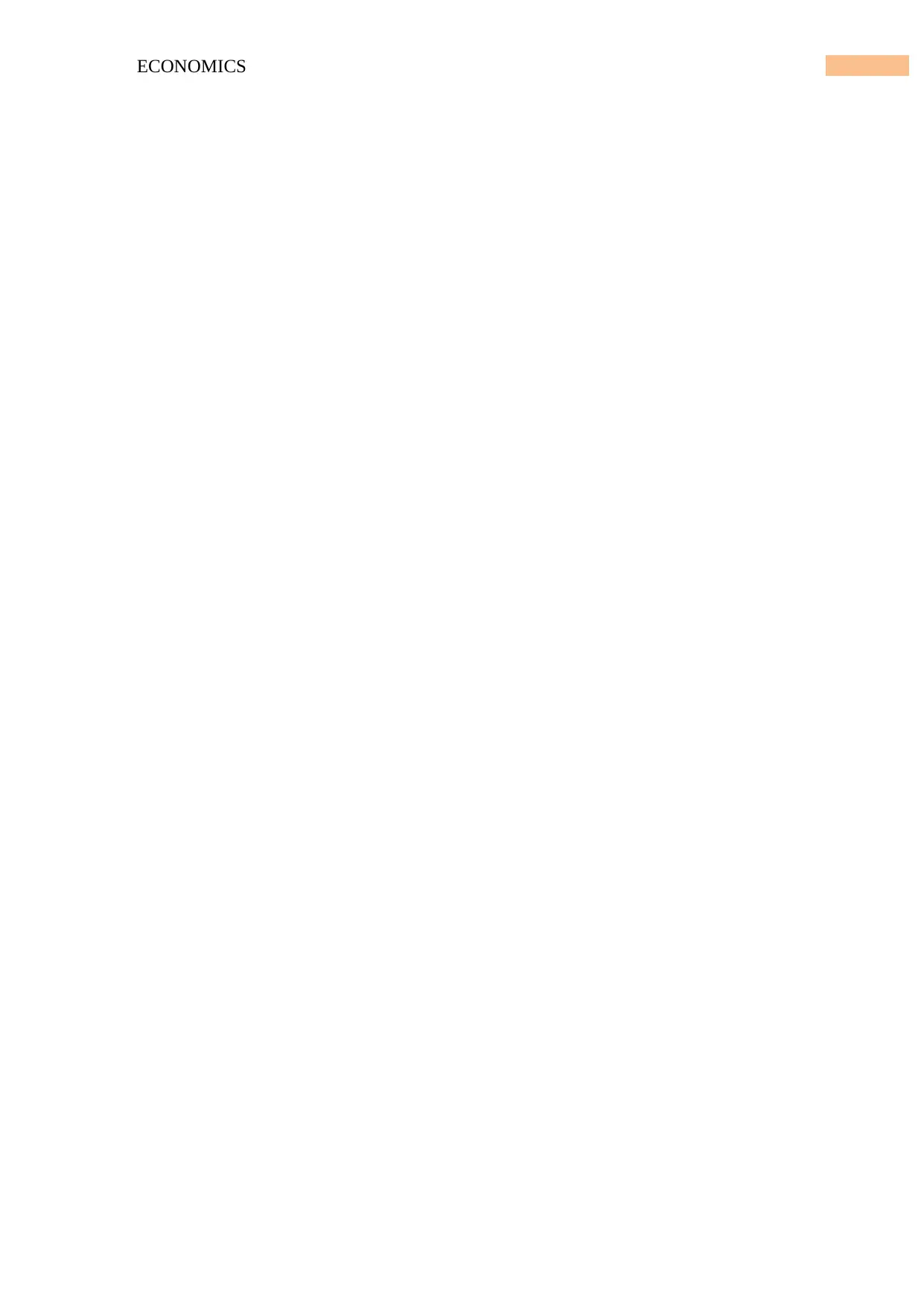
6ECONOMICS
1 out of 7
Related Documents
Your All-in-One AI-Powered Toolkit for Academic Success.
+13062052269
info@desklib.com
Available 24*7 on WhatsApp / Email
![[object Object]](/_next/static/media/star-bottom.7253800d.svg)
Unlock your academic potential
Copyright © 2020–2025 A2Z Services. All Rights Reserved. Developed and managed by ZUCOL.





